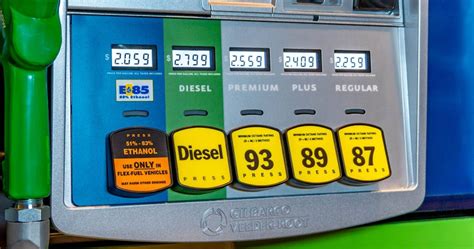
Ford Flex Fuel Efficiency: Unraveling the Facts
In the pursuit of sustainable mobility, fuel efficiency has emerged as a critical factor influencing vehicle selection. Recognizing this growing demand, Ford has introduced a range of flex-fuel vehicles that promise both performance and environmental consciousness. This article delves into the intricacies of Ford's flex fuel technology, exploring its advantages, limitations, and real-world fuel efficiency figures.
Understanding Flex-Fuel Vehicles: A Paradigm Shift in Fuel Options
Flex-fuel vehicles, also known as flexible-fuel vehicles (FFVs), represent a technological leap forward in the automotive industry. These vehicles are designed to operate on various fuel blends, including gasoline, ethanol, or a combination of both. This versatility stems from modifications to the engine and fuel system, allowing FFVs to seamlessly adapt to different fuel compositions. The primary advantage lies in the ability to utilize renewable ethanol, a biofuel derived from plant sources, thereby reducing greenhouse gas emissions and promoting sustainable practices.
The Ethanol Advantage: Unveiling the Environmental Benefits
Ethanol, the key component in flex-fuel blends, holds immense promise as a renewable and environmentally friendly fuel alternative. Its production from crops like corn or sugarcane mitigates the reliance on fossil fuels and reduces greenhouse gas emissions by up to 60%. Moreover, ethanol contributes to cleaner air by reducing smog-forming pollutants and particulate matter emissions. By embracing flex-fuel technology, motorists can actively contribute to a greener and more sustainable future.
Addressing the Efficiency Question: Unveiling Real-World Fuel Economy
While flex-fuel vehicles offer the flexibility to utilize various fuel blends, questions arise regarding their fuel efficiency compared to conventional gasoline-powered vehicles. Real-world fuel economy figures for flex-fuel vehicles vary depending on several factors, including the vehicle model, driving conditions, and the fuel blend used. On average, FFVs tend to exhibit a slight decrease in fuel efficiency when operating on E85 (a blend of 85% ethanol and 15% gasoline) compared to gasoline alone. However, the environmental benefits associated with ethanol often outweigh this marginal reduction in fuel efficiency.
Maximizing Fuel Efficiency in Flex-Fuel Vehicles: Adopting Prudent Driving Habits
Just like conventional vehicles, flex-fuel vehicles can achieve optimal fuel efficiency by adopting responsible driving habits. Maintaining moderate speeds, avoiding aggressive acceleration and braking, and utilizing cruise control on highways can significantly improve fuel economy. Additionally, regular vehicle maintenance, including proper tire inflation and periodic tune-ups, ensures peak engine performance and contributes to better fuel efficiency.
The Economic Considerations: Evaluating the Cost-Effectiveness of Flex-Fuel Vehicles
The cost-effectiveness of flex-fuel vehicles depends on various factors, including fuel prices, government incentives, and individual driving patterns. While flex-fuel vehicles may carry a slightly higher initial cost compared to gasoline-only vehicles, potential savings can be realized through lower fuel costs, especially in regions where ethanol is competitively priced. Moreover, some governments offer financial incentives, such as tax breaks or rebates, to promote the adoption of flex-fuel vehicles.
The Availability Factor: Expanding the Flex-Fuel Infrastructure
The widespread adoption of flex-fuel vehicles relies heavily on the availability of refueling infrastructure. Currently, the distribution of ethanol fuel stations varies across regions, with some areas having a denser network than others. However, efforts are underway to expand the flex-fuel infrastructure, making it more accessible to motorists. The increasing demand for flex-fuel vehicles is likely to drive further investment in expanding refueling stations, ensuring greater convenience for drivers.
The Future of Flex-Fuel Technology: Exploring Advanced Innovations
The evolution of flex-fuel technology continues to yield exciting advancements. Ongoing research and development efforts are focused on improving engine efficiency, optimizing fuel blends, and exploring alternative ethanol sources. The integration of hybrid and electric powertrains with flex-fuel technology holds the potential for even greater fuel savings and reduced emissions. These innovations promise to further enhance the environmental and economic benefits of flex-fuel vehicles, making them an increasingly attractive option for eco-conscious consumers.
Conclusion: Embracing Flex-Fuel Vehicles for a Sustainable Future
Ford's flex-fuel technology represents a significant step towards sustainable mobility. By offering vehicles capable of utilizing renewable ethanol blends, Ford empowers drivers to make a positive impact on the environment. While there are considerations regarding fuel efficiency and infrastructure availability, the advantages of flex-fuel vehicles in terms of environmental benefits and potential cost savings make them a compelling choice for those seeking a balance between performance and sustainability. As technology continues to advance and the flex-fuel infrastructure expands, flex-fuel vehicles are poised to play an increasingly vital role in shaping a greener and more sustainable future.